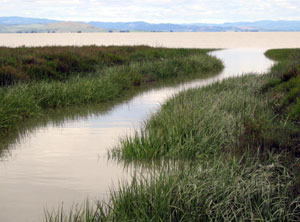 The spot where I am sitting used to be Bay.
The spot where I am sitting used to be Bay.
And yet these days-- even from my second story office window at the old Hamilton Army Airfield-- you can’t see water. In fact, you’d have to walk past a couple blocks of houses, climb a levee, cross acres of abandoned and weed-studded runways, and scramble over another levee before even having to worry about your toes getting wet.
It is the same story all around the Bay, which was once ringed with 196,000 acres of wetlands. These wetlands supported huge flocks of shorebirds and waterfowl, served as key nursery habitat for fish and for invertebrates, and were home to unique species like the California Clapper Rail and Salt Marsh Harvest Mouse (both now endangered). All that has changed. Since the days of the Gold Rush, more than a third of the San Francisco Bay Estuary has been drained or filled. About 85% of its wetlands are gone. (Some of you, like me, may be sitting on them right now).
Hamilton is typical. What was to become the Airfield was first diked in the late 1800s, much like many similar sites around San Pablo Bay. The onetime wetlands became farmland for oat hay and peas. The Federal Government bought the land in 1932 and built the airfield, which provided key support for troops from WW II through Vietnam.
Now, in what some might consider the ecological equivalent of beating swords into ploughshares, some 700 acres of the land once occupied by the military is being readied to be ceded back to its original inhabitants: birds, fish, pickleweed, the mud and tidal waters of San Francisco Bay. Dredge material from the Port of Oakland will be brought in to top the runways (which have subsided below sea level), and then eventually the levees will be breached and the Bay will reconquer a bit of land. The acquisition of another parcel in Bel Marin Keys just to the north of Hamilton has the potential to make this a 2,600 acre restoration.
